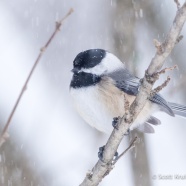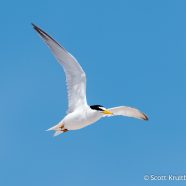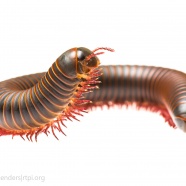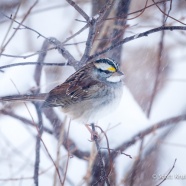Black-capped Chickadee
This may be the last look at a seasonal Sunday bird with snow this winter as it is now meteorological spring! Now that we have crossed into March, cavity-nesting birds like this Black-capped Chickadee (Poecile atricapillus) will be looking for nesting sites. If you enjoy hosting wild birds by providing nest boxes, now is the time to get them ready. Have you ever put out dog fur for birds to use as nesting material? Chickadees, and other small songbirds that use nest boxes and cavities like the Tufted Titmouse, will take fur that you put out in say, an empty suet cage, and use it to line...
Read MoreWill the Big Night be Coming Soon?
Have you seen any signs of spring yet? We certainly have! Robins are actively feeding, red-winged blackbirds are beginning to sing, and it won’t be long before our resident salamanders come out from their winter refuges. Conditions have to be just right to entice them out from under their chosen cover objects; a warm 40° night with rain sets the stage for spotted salamanders to begin their migration. Will we soon see the required circumstances to set this charismatic species on the move? Keep an eye on the weather and another on nearby pools and ponds so as not to miss the big...
Read MoreAAfCW 2017 Training Saturday
The Audubon Alliance for Coastal Waterbirds/CT DEEP 2017 monitoring and stewardship season is about to begin! Please see below for details, and please pass this along to any new volunteers you feel would be interested in joining us. We hope all our past monitors will be returning this year after yet another record-setting season in 2017. We can only keep this success going with your help! Spend your summer days at the beach and help protect a federally threatened species! The Connecticut Department of Energy and Environmental Protection and the Audubon Alliance for Coastal Waterbirds are...
Read MoreRoly-poly-pede
This Giant Millipede (Narceus americanus) doesn’t really have 1,000 legs. However, like all millipedes, it has two pairs of extremities on each of its body segments (centipedes always have only a single pair per body segment). Unlike their centipede ‘cousins’, millipedes lack the modified jaw-like first pair of legs that predatory centipedes use to catch and sometimes envenomate their prey. Instead, millipedes defend themselves by rolling into a tight spiral and/or using chemical defenses that can include cyanide! Worst case scenario, handling one of these beautiful ‘roly-poly-pedes’...
Read MoreWhite-throated Sparrow
Here is a photo of a White-throated Sparrow (Zonotrichia albicollis) toughing it out in a recent snowstorm. Despite the fact that we were in the middle of February, this bird was already sporting its spring courting plumage; evidenced by its bright white throat and vibrant yellow lores. This is one of the first species you can expect to hear singing at the end of winter; their “oh-sweet-Canada” or “poor-Sam-Peabody” tune resonates from the brush. In some cases you might see White-throated Sparrows year-round – some birds will overwinter in the Northeast and head...
Read MoreDragons of the Northeastern Forest?
Do you still consider yourself to be a kid at heart? I definitely have my own “kid” moments when I’m out in the field flipping logs or dip netting pools to see what may be living beneath the surface of the forest floor or a body of water. One species in particular that I love to find in our northeastern forests is the spotted salamander (Ambystoma maculatum). Known for their large black bodies spotted with bright yellow dots, this charismatic species is hard to miss when out in the open. However, they are typically only seen out and about once a year; during their spring...
Read More









